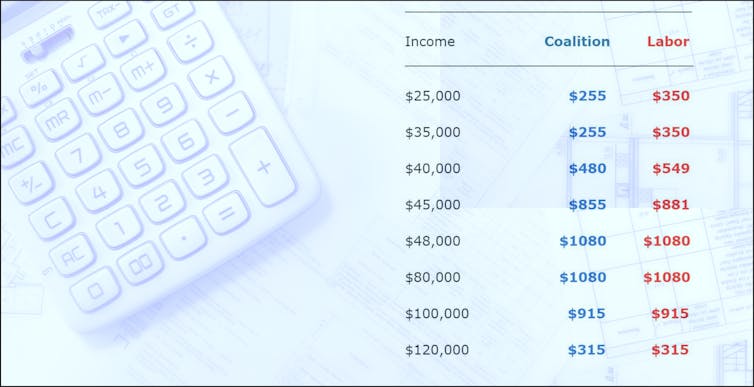
Leader of the Opposition Bill Shorten delivers the 2017-18 Federal Budget reply speech on Thursday, May 11, 2017. Source: AAP/Mick Tsikas.
By Peter Martin, Australian National University
With all the announcements on tax over the past few days, it’s hard to keep track. So here it goes.
A year ago, then-treasurer Scott Morrison unveiled a “seven-year personal tax plan”.
Some of it involved tax cuts way out into the future, in 2022 and 2024, with which we needn’t concern ourselves, because there would be two, maybe more, elections before then.
The bit that was to start in mid-2018 (and did) wasn’t a tax cut at all, strictly speaking. It was an “offset” with an ungainly name: LMITO (the low- and middle-income tax offset).
A standard tax cut, applying to any rate, would save money to all taxpayers on that rate and rates above it, including those on very high incomes. It couldn’t be directed to just low and middle earners, which is what the coalition wanted.
What’s on offer isn’t really a tax cut
So the coalition designed an offset, to be paid as a lump sum after the end of each tax year, after returns had been submitted and only to those taxpayers whose returns showed they weren’t high earners.
The full offset was $530 per year, paid only to taxpayers who earned between $48,000 and $90,000. Taxpayers who earned more than $90,000 would lose 1.5 cents of it for each dollar they earned above $90,000, meaning no one who earned more than $125,333 would get any of it.
(Although taxpayers earning more than $125,333 wouldn’t go home completely empty-handed — they would benefit from an increase in the point at which the second highest rate came in, worth a barely consequential $135 a year.)
Taxpayers who earned less than $37,000 would get $200 off their tax, climbing to $530 for taxpayers earning $48,000.
It was ungainly — it was better described as a series of annual lump sum payments than a tax cut — and Labor embraced it entirely.
In 2018, Labor trumped it
Except that Labor supercharged it. Under Labor it was to operate in exactly the same way, except that each payment would be 75% bigger: the coalition’s $200 became Labor’s $350, the coalition’s $538 became Labor’s $928, and so on.
Labor outbid the coalition.
And these things stayed, for almost a year, except that it was all a bit academic.
Labor wasn’t in government, and the legislated offsets weren’t to put the lump sums in pockets until after the end of June 2019.
In 2019, the coalition trumped Labor
It allowed the coalition to sneak in before them in Tuesday’s budget and double the maximum lump sum: $538 became $1,080, a promise Bill Shorten matched in his budget reply speech on Thursday night.
But for some reason the coalition didn’t double everything: $200 only became $255, rather than the $350 Labor had already promised.
On Thursday night Shorten confirmed the $350 promise.
He is able to offer the 3.6 million Australians earning less than $48,000 more than the Coalition — in most cases, an extra $95 ($350 instead of $255).
Now Labor has trumped the coalition
Shorten says it’ll cost an extra $1 billion over four years, which is a mere fraction of the money Labor believes it will have that the coalition won’t, because of its crackdowns on negative gearing, capital gains tax concessions and dividend imputation.
As Shorten put it on Thursday night: “Labor will provide a bigger tax cut than the Liberals for 3.6 million Australians all-told, an extra $1 billion for low-income earners in this country. Here’s the simple truth: 6.4 million working people will pay the same amount of income tax under Labor as the Liberals. Another 3.6 million will pay less tax under Labor.”
In fac,t they’ll pay just as much tax from payday to payday, but they’ll get back more at the end of the year, in most cases $95 more.
So here’s the scorecard.![]()

Annual tax offset by taxable income. Source: Australian Labor Party.
This article is republished from The Conversation under a Creative Commons license. Read the original article.
NOW READ: The two glaring tax issues that weren’t addressed in the budget
COMMENTS
SmartCompany is committed to hosting lively discussions. Help us keep the conversation useful, interesting and welcoming. We aim to publish comments quickly in the interest of promoting robust conversation, but we’re a small team and we deploy filters to protect against legal risk. Occasionally your comment may be held up while it is being reviewed, but we’re working as fast as we can to keep the conversation rolling.
The SmartCompany comment section is members-only content. Please subscribe to leave a comment.
The SmartCompany comment section is members-only content. Please login to leave a comment.